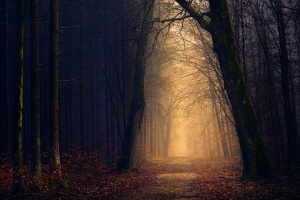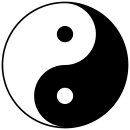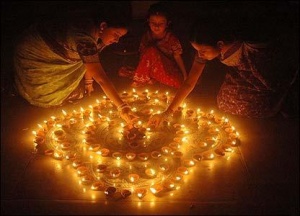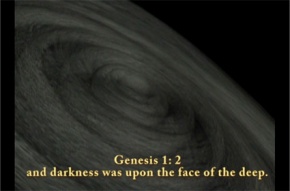Darkness
Darkness in its most common usages is a term that indicates the absence of light, or the presence of evil. As a physical phenomenon that every person experiences daily, it has taken on many religious, psychological, and symbolic meanings.
Theosophical viewpoint
Darkness, in the Theosophical literature, is a term applied in different ways. It generally refers to the Absolute, to the universe in pralaya or to pre-cosmic principles, before the manifestation of the cosmos.
According to the tenets of Eastern Occultism, DARKNESS is the one true actuality, the basis and the root of light, without which the latter could never manifest itself, nor even exist. Light is matter, and DARKNESS pure Spirit. Darkness, in its radical, metaphysical basis, is subjective and absolute light; while the latter in all its seeming effulgence and glory, is merely a mass of shadows, as it can never be eternal, and is simply an illusion, or Maya.[1]
Meaning of the term
In the context of universal principles, the word "darkness" is used to refer to those principles that are beyond our comprehension, so that they appear as darkness to our minds:
[The] source is unknown, though as strongly demanded by reason and logic, therefore it is called “Darkness” by us, from an intellectual point of view.[2]
It is Darkness most unquestionably to our intellect, inasmuch as we can know nothing of it. I told you already that neither Darkness nor Light are to be used in the sense of opposites, as in the differentiated world.[3]
At the level of these universal principles we are not talking about light or its absence. Therefore this "darkness" is not the opposite of light:
In the sense of objectivity, both light and darkness are illusions—maya; in this case, it is not Darkness as absence of Light, but as one incomprehensible primordial Principle, which, being Absoluteness itself, has for our intellectual perceptions neither form, colour, substantiality, nor anything that could be expressed by words.[4]
The term darkness is sometimes used in a relative way:
In using figurative language, as has been done in The Secret Doctrine, analogies and comparisons are very frequent. Darkness for instance, as a rule, applies only to the unknown totality, or Absoluteness. Contrasted with eternal darkness, the first Logos is certainly Light; contrasted with the second or third, the manifested Logos, the first is Darkness, and the others are Light.[5]
In the same way it can be said that what is darkness to the regular mind, may not necessarily be so to the mystic or the Adept:
[It] is absolute darkness to the scientific mind, and but a gray twilight to the perception of the average mystic, though to that of the spiritual eye of the Initiate it is absolute light.[6]

The Absolute
The ultimate darkness is the absolute reality, which cannot be perceived even by the Logos:
Q. What is Ever-Darkness in the sense used here?
A. Ever-Darkness means, I suppose, the ever-unknowable mystery, behind the veil—in fact, Parabrahm. Even the Logos can see only Mulaprakriti, it cannot see that which is beyond the veil. It is that which is the “Ever-unknowable Darkness.”[7]
The Absolute being the source of everything, in the Theosophical Literature it is said that darkness is the source of light:
If the absolute deity can be referred to as Darkness or the Dark Fire, the light, its first progeny, is truly the first self-conscious god.[8]
For the Occultist, the Rosecroix of the Middle Ages, and even the mediaeval Kabalists, said that to our human perception and even to that of the highest “angels,” the universal Deity is darkness, and from this Darkness issues the Logos. . .[9]
But esoterically, it is Darkness itself, the unknowable Absolute which is the Source, firstly of the radiation called the First Logos, then of its reflection, the Dawn, or the Second Logos, and finally of Brahmâ, the manifested Light, or the Third Logos.[10]
Thus, the Darkness is regarded as eternal, while the appearance of light (or manifestation) is a non-eternal phenomena occurring periodically.[11]
Pralaya
According to Madame Blavatsky, darkness can represent a time of absolute rest:
Darkness is taken as the appropriate allegorical representation of the condition of the Universe during Pralaya, or the term of absolute rest, or non-being, as it appears to our finite minds.[12]
When the whole universe was plunged in sleep—had returned to its one primordial element—there was neither centre of luminosity, nor eye to perceive light, and darkness necessarily filled the boundless all.[13]
Pre-cosmic Principles
In some instances the term "darkness" is applied to the pre-cosmic principles, especially when they are mentioned in reference to the manifested elements. The first or unmanifested Logos is called in Stanzas of Dzyan Stanza III.8 "the dark hidden father" as opposed to the manifested "white brilliant son".[14] Darkness is also used to refer to the the first cosmic element, "the waters" or "chaos", before it differentiated into the different planes.[15]
Satan and Lucifer
H. P. Blavatsky wrote of the term darkness as applied to Satan, "The Prince of Darkness." However, Satan is also related to Lucifer, which means "the light bearer":
Even in the mind-baffling and science-harassing Genesis, light is created out of darkness “and darkness was upon the face of the deep” (ch. i. v. 2.)—and not vice versâ. “In him (in darkness) was life; and the life was the light of men” (John i. 4). A day may come when the eyes of men will be opened; and then they may comprehend better than they do now, that verse in the Gospel of John that says “And the light shineth in darkness; and the darkness comprehendeth it not.” They will see then that the word “darkness” does not apply to man’s spiritual eyesight, but indeed to “Darkness,” the absolute, that comprehendeth not (cannot cognize) transient light, however transcendent to human eyes.[16]
Demon est Deus inversus. The devil is now called Darkness by the Church, whereas, in the Bible he is called the “Son of God” (see Job), the bright star of the early morning, Lucifer (see Isaiah). There is a whole philosophy of dogmatic craft in the reason why the first Archangel, who sprang from the depths of Chaos, was called Lux (Lucifer), the “Luminous Son of the Morning,” or manvantaric Dawn. He was transformed by the Church into Lucifer or Satan, because he is higher and older than Jehovah, and had to be sacrificed to the new dogma.[17]
Religious views of darkness
Darkness is a rich subject in the religions of the world, represented by the following examples.
Buddhism
Sakyamuni Buddha claims that darkness of the mind (mumyo no yami) is the real cause of suffering. This refers to fundamental darkness or ignorance about the purpose of life, which contrast with the nature of enlightenment or realization of the Buddha nature.
The central practice of Shin Buddhism is a chant, “Namu Amida Butsu” (also known as the nembutsu), in which the Buddhist calls upon himself to "come just as I am, with my heart of mumyo, darkness. It is only when one identifies totally with mumyo, the heart of darkness, that the walls of the proud ego-self are shattered and the true light of wisdom can shine through in one’s actions."[18]
Taoism
Taoism regards darkness as the ultimate source. The first chapter of the Tao Te Ching says:
- Yet mystery and manifestations
- arise from the same source.
- This source is called darkness.
- Darkness within darkness.
- The gateway to all understanding.
Darkness also manifests in polarity with light, without being in opposition. This concept is exemplified by the Yin Yang symbol, which represents light and darkness interlocked in perfect balance. Alan Watts wrote, "At the very roots of Chinese thinking and feeling there lies the principle of polarity, which is not to be confused with the ideas of opposition or conflict. In the metaphors of other cultures, light is at war with darkness, life with death, good with evil, and the positive with the negative, and thus an idealism to cultivate the former and be rid of the latter flourishes throughout much of the world."[19]
Hinduism
Goodness and evil, light and darkness coexist in every person, following the pattern of the ancient powers called the Devas and Asuras in the Vedic literature:
The Devas and Asuras, Angels and Titans, powers of Light and powers of Darkness in Rigveda, although distinct and opposite in operation, are in essence consubstantial, their distinction being a matter not of essence but of orientation, revolution or transformation. In this case, the Titan is potentially an Angel, the Angel still by nature a Titan; the Darkness in actu is Light, the Light in potentia Darkness; whence the designations Asura and Deva may be applied to one and the same Person according to the mode of operation.[20]
Hindu deities linked to darkness include Ratri, goddess of the night, and Rahu is the celestial deity of darkness and eclipses.
Diwali, or Deepawali, is an annual festival of lights celebrated as a national holiday in India and by Hindus everywhere. It represents the victory of light over darkness, knowledge over ignorance, and triumph of the good over the lower nature. The festival extends over several days, with the most important day falling in the dark of the moon of the Hindu lunisolar month Kartika in Bikram Sambat calendar (mid-October and mid-November). Hindus clean their homes in advance of Diwali, and participate in family puja (prayers) to the goddess Lakshmi. They enjoy special foods, exchange gifts, and light lamps, candles, and fireworks.
Judaism
The Book of Genesis (or Bereishit), the first book of the Hebrew Bible, describes darkness as an aspect of the chaos out of which God created the Earth as we know it. The heaven and earth when first created were formless, empty, and dark:
- 1 In the beginning God created the heaven and the earth.
- 2 And the earth was without form, and void; and darkness was upon the face of the deep. And the Spirit of God moved upon the face of the waters.
- 3 And God said, Let there be light: and there was light.
- 4 And God saw the light, and it was good; and God divided the light from the darkness. (Genesis 1.1-4)
Light, in this presentation, does not belong to this world, but is an emanation from another reality.
Darkness is an attribute of the afterlife. Sheol, where all go after death, is a place of of stillness and darkness, cut off from life and from God.
Hanukkah or Chanukah is a festival of lights and rededication that takes place over eight days. It commemorates the rededication of the Second Temple, during which the consecrated oil that normally would have been sufficient to stave off the darkness for one night was miraculously able to provide light for eight nights. On each night of Hanukkah in a Jewish home, another of the eight candles in a menorah (candlabrum) is lit from a central candle.
Christianity
Traditionally, Christians have identified darkness with sin, ignorance, spiritual blindness, and death.[21] Hundreds of verses in the Christian Bible refer to light and darkness. Fear of darkness and an emphasis on reaching for the light characterize many modern Christians and their churches. However, as former Episcopalian priest Barbara Brown Taylor points out:
darkness was often the setting for humanity’s closest encounters with the divine. God appeared to Abraham in the night and promised him descendants more numerous than the stars. The exodus from Egypt happened at night. God met Moses in the thick darkness atop Mount Sinai to hand down the Ten Commandments. The apostle Paul’s conversion happened after he lost his sight. Jesus was born beneath a star and resurrected in the darkness of a cave. [22]
Here are a few aspects of darkness from the Christian perspective:
- During Easter week, many Christians participate in a Tenebrae (“shadow”) service to understand the spiritual darkness suffered by Jesus during his arrest and crucifixion. Churches are darkened in a ritual that helps congregants to explore the sense of spiritual loss and abandonment.
- The dark night of the soul is a term in Roman Catholic spirituality describing a spiritual crisis such as those famously experienced by St. John of the Cross, St. Thérèse of Lisieux, and St. Teresa of Calcutta. Such a period of crisis may be brief or lengthy, and typically involves profound doubt, confusion, anger, desolation, depression, and despair. Trials, temptations, and a sense of abandonment may accompany the experience. The dark night should be considered an opportunity for dramatic spiritual advancement as illusions and attachments are cast aside.
- Mediaeval Christian mystics such as Pseudo-Dionysius the Areopagite or texts like The Cloud of Unknowing use the word darkness to refer to the highest and unknowable aspect of the Godhead.
Islam
Darkness is considered to be the necessary opposite to light. In order to know and identify anything, its opposite must be brought to the same place so the contrasts become apparent. Light can not be identified and distinguished unless darkness exists. Other references to darkness in Islam:
- Jahiliyya is the word used to describe the period of ignorance and darkness preceding Islam. It also refers to the general condition of those who have not accepted Islam - unbelievers, infidels, or heretics.
- Light provides guidance, and darkness is ignorance.
- The Quran has verses in which God talks about moving from darkness towards light as the purification of the soul.
- In the Quran (Nab 78.25), people who commit transgressions are doomed to “burning despair and ice-cold darkness”.
Darkness in psychology
Darkness in the arts and popular culture
- The Cloud of Unknowing frequently appears in music, film, and literature.
- Conrad, Joseph. The Heart of Darkness. 1899. Conrad's classic work explores psychological darkness during a journey upriver into the Congo, on the Dark Continent.
- Le Guin, Ursula K. The Left Hand of Darkness. This novel uses an androgynous society to explore Taoist ideas that the line between Yin and Yang represents balance. Darkness and light are not in opposition, but exist in harmony, as should be the case between male and female.
- T. S. Eliot wrote in his poem “East Coker”:
- I said to my soul, be still, and let the
- dark come upon you
- Which shall be the darkness of God.
Additional Resources
- "Darkness" at Theosopedia
- Chapman, Emily Stimpson. "Understanding the Dark Night of the Soul". OSV Newsweekly. 5/20/2015.
- Freeman, Tzvi. "Getting Past the Mind" at Chabad.org.
- Moreira-Ramirez, Nathalie. "Taoism and The Left Hand of Darkness". May 5, 2013.
- Ortberg, Nancy. Seeing in the Dark: Finding God’s Light in the Most Unexpected Places. Carol Stream, IL: Tyndale House Publishers, Inc., 2015.
- Taylor, Barbara Brown. Learning to Walk in the Dark. New York: HarperOne, 2014.
- "100 Bible Verses about Darkness" in OpenBible.info. Accessed July 6, 2018.
Notes
- ↑ Helena Petrovna Blavatsky, The Secret Doctrine vol. I, (Wheaton, IL: Theosophical Publishing House, 1993), 70.
- ↑ Helena Petrovna Blavatsky, The Secret Doctrine vol. I, (Wheaton, IL: Theosophical Publishing House, 1993), 40.
- ↑ Helena Petrovna Blavatsky, Collected Writings vol. X (Wheaton, IL: Theosophical Publishing House, 1988), 337.
- ↑ Helena Petrovna Blavatsky, Collected Writings vol. X (Wheaton, IL: Theosophical Publishing House, 1988), 331.
- ↑ Helena Petrovna Blavatsky, Collected Writings vol. X (Wheaton, IL: Theosophical Publishing House, 1988), 368.
- ↑ Helena Petrovna Blavatsky, The Secret Doctrine vol. I, (Wheaton, IL: Theosophical Publishing House, 1993), 41.
- ↑ Helena Petrovna Blavatsky, Collected Writings vol. X (Wheaton, IL: Theosophical Publishing House, 1988), 351.
- ↑ Helena Petrovna Blavatsky, Collected Writings vol. X (Wheaton, IL: Theosophical Publishing House, 1988), 375.
- ↑ Helena Petrovna Blavatsky, Collected Writings vol. X (Wheaton, IL: Theosophical Publishing House, 1988), 376.
- ↑ Helena Petrovna Blavatsky, Collected Writings vol. X (Wheaton, IL: Theosophical Publishing House, 1988), 376.
- ↑ Helena Petrovna Blavatsky, Collected Writings vol. X (Wheaton, IL: Theosophical Publishing House, 1988), 351.
- ↑ Helena Petrovna Blavatsky, The Secret Doctrine vol. I, (Wheaton, IL: Theosophical Publishing House, 1993), 69.
- ↑ Helena Petrovna Blavatsky, The Secret Doctrine vol. I, (Wheaton, IL: Theosophical Publishing House, 1993), 41.
- ↑ Helena Petrovna Blavatsky, The Secret Doctrine vol. I, (Wheaton, IL: Theosophical Publishing House, 1993), 77.
- ↑ Helena Petrovna Blavatsky, Collected Writings vol. X (Wheaton, IL: Theosophical Publishing House, 1988), 366.
- ↑ Helena Petrovna Blavatsky, The Secret Doctrine vol. I, (Wheaton, IL: Theosophical Publishing House, 1993), 70.
- ↑ Helena Petrovna Blavatsky, The Secret Doctrine vol. I, (Wheaton, IL: Theosophical Publishing House, 1993), 70-71.
- ↑ Patti Nakai, "Confronting the Heart of Darkness" Tricycle Summer 2017.
- ↑ Alan Watts, https://creativesystemsthinking.wordpress.com/2015/07/31/the-taoist-view-of-the-universe-alan-watts/ "The Taoist View of the Universe"] Posted July 31, 2015 in Creative by Nature blog. Accessed 7/5/2018.
- ↑ Ananda Coomaraswamy. "Angel and Titan: An Essay in Vedic Ontology" Journal of the American Oriental Society vol. 55 (1935), 373-374.
- ↑ Barbara Brown Taylor, "In Praise of Darkness" Time Magazine April 17, 2014.
- ↑ Elizabeth Dias, "Barbara Brown Taylor Faces the Darkness" Time Magazine April 28, 2014.




